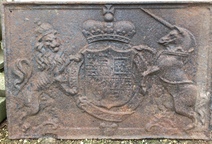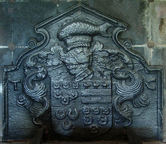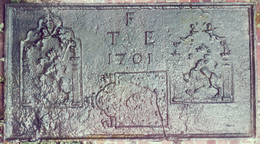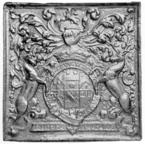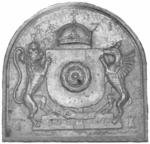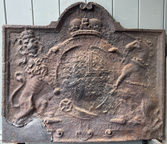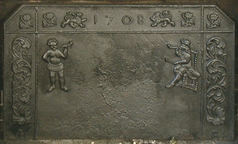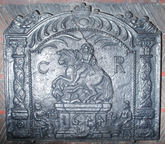-
487
Description: Rectangular; cavetto-moulded edging; shield, garter, supporters and crown of the English royal house of Stuart.
Notes: One of many designs of the Stuart royal arms on firebacks. Another, corroded version of this fireback measures 900mm x 610mm. Criterion Auctions, Bath, 10 Sep 2016 lot 168.
Copies of this fireback are known.
Inscription: HONY SOIT QUI MAL Y PENSE
Arms: English Stuart royal
- Decoration tags:
- rectangular (shape)
- cavetto (edging)
- whole carved pattern
- armorial
- royal
Manufactured: in the mid- to late-17th century in England.
Current location: not known.
- Attached to series:
- Stuart royal armorial firebacks
-
857
Description: Rectangular with detached pediment linked by S-curves, protruding from each of which is a small scroll; cavetto-moulded edging (top and sides); quartered shield with helm, crest and mantling; initials in top corners.
Notes: The arms are of Sir Julius Caesar (1558-1636), judge and politician, Chancellor of the Exchequer 1606-13. Blazon: Quarterly, 1st and 4th, Gules, three roses argent, on a chief of the second three roses of the first (Caesar); 2nd, argent, two bars sable, on a chief of the second three swans of the first (?Martin); 3rd, gules, three crescents argent (Peryent/Perin). Crest: a dolphin embowed in the sea vert. This example has the additional initials, TC. The style of the carving is the same as on two other firebacks in the same county.
Copies of this fireback are known.
Inscription: T C
Arms: Caesar
- Decoration tags:
- rectangular with detached pediment (shape)
- cavetto (edging)
- whole carved pattern
- individual letters
- planklines
- armorial
- text
Manufactured: in the early-17th century possibly in the Herefordshire area of England.
Current location: Croft Castle, Yarpole, Herefordshire, England.
Museum number: 537532 (part of the National Trust museum group)
- Attached to series:
- Personal armorial firebacks
- Loop edged firebacks
- Herefordshire armorial series
-
1011
Description: Rectangular shape with cavetto-moulded edging; top centre, initials in triad with date below; on each side, stamp formed of a small, wavy-arched rectangular fireback bearing a lion rampant between pilasters surmounted by burning cauldrons, beneath two mirrored putti holding branches; beneath the date, a stamp formed of a small arched-rectangular fireback laid on its left side with a burning cauldron on each shoulder and the faint figure of a bird in the centre.
Notes: The two identical fireback stamps on either side of the inscription have been noted elsewhere (see no. 210 Late Pictorial series 5); the centre and right fireback stamps have been impressed insufficiently; illustration from Country Life advertisement by T. Crowther & Son Ltd, 18 Oct 1984.
Inscription: TFE [triad] / 1701
- Decoration tags:
- rectangular (shape)
- cavetto (edging)
- composite
- individual letters
- individual numbers
- pictorial
- architectural
- text
- animals
Manufactured: in 1701 in England.
Current location: not known.
- Attached to series:
- Composite firebacks
- Late pictorial series (all)
- Late pictorial series 5
-
268
Description: Rectangular; cavetto moulded edging; shield, garter, coronet, helm, crest, supporters and motto of Villiers, 1st Duke of Buckingham.
Notes: The arms are those of George Villiers (1592-1628), created Duke of Buckingham in 1623. Blazon: Quarterly 1, Villiers (modern) - argent, on a cross gules five scallops or; 2, Villiers (ancient) - sable, a fess between three cinquefoils argent; 3, Pakeman - gules, a chevron between three crosses botonnee fitchee argent; 4, Bellers - per pale gules and sable, a lion rampant argent crowned or; 5, Hoby - azure, a bend between six mullets argent; 6, Kirkby - argent, a cross between two annulets vert.
Copies of this fireback are known.
Inscription: HONI SOIT QVY MAL Y PENSE / FIDEI COTICULA CRUX [The cross is the touchstone of faith]
Arms: George Villiers, 1st Duke of Buckingham
- Decoration tags:
- rectangular (shape)
- cavetto (edging)
- whole carved pattern
- planklines
- armorial
Manufactured: in the early-17th century in England.
Current location: not known.
Citation: Dawson, C., 1903, 'Sussex Iron Work and Pottery', Sussex Archaeological Collections, 46, pp. 1-54.
- Attached to series:
- Personal armorial firebacks
- Bristol armorial group
-
269
Description: Arched; cavetto edging; crowned plain shield bearing a Tudor rose, with crowned lion and dragon supporters, with garter and motto; date split by crown.
Notes: The numerals are more typically 16th century in form than are found on copies produced from the late-19th century (see no. 178), suggesting this may be the original design; illustration from Dawson (1903).
Inscription: 15 71 / T K; [English royal, and garter, mottoes].
- Decoration tags:
- rounded arched (shape)
- cavetto (edging)
- whole carved pattern
- individual letters
- individual numbers
- heraldic
- royal
Manufactured: in 1571 in the Weald area of England.
Current location: not known.
Citation: Dawson, C., 1903, 'Sussex Iron Work and Pottery', Sussex Archaeological Collections, 46, pp. 1-54.
- Attached to series:
- Miscellaneous royal firebacks
-
1312
Description: Arched rectangular shape with small rhomboidal flanges in the corners of the arch, the top of the arch comprising two opposing loops; cavetto moulded edging; crowned circular shield within a Garter of the Stuart royal arms of England with crowned lion and unicorn supporters.
Notes: One of several variations of the arms of the Stuart royal dynasty on firebacks. Duke's auctioneers, Dorchester, Dorset, 10 Jun 2025, lot 9.
Copies of this fireback are known.
Inscription: [Garter and royal mottoes illegible]
Arms: English Stuart royal
- Decoration tags:
- rectangular with round arch (shape)
- cavetto (edging)
- whole carved pattern
- heraldic
- armorial
- royal
Manufactured: in the mid- to late-17th century in England.
Current location: not known.
- Attached to series:
- Stuart royal armorial firebacks
-
55
Description: Canted rectangle; cavetto moulded edging (top and sides); single horizontal fillet below canted corners and vertical fillet parallel to each side, dividing the fireback into two side panels, two top corner panels, top panel and main central panel; ‘daisy’ plant stamp in top corners, and at outer end of top panel enclosing two, opposite facing, lion passant stamps with date between; swirling foliage stamp repeated in each side panel above initial, I to left, B to right; stamp of ‘Indian’ smoking a pipe in top left of central panel, stamp of seated ‘gentleman’ smoking a pipe and holding another, at top right.
Notes: The 'daisy' stamp and the IB initials are identical to those on similar firebacks dated between 1703 and 1721, and probably indicating the same founder. The use of stamps relating to tobacco smoking may suggest an origin near Bristol, the main entry port for the tobacco trade at that time. Lent to Dyrham Park by the late John Workman OBE, of Sheepscombe, Gloucs. in 1963, and given in 1996.
Inscription: 1708 / I B
- Decoration tags:
- rectangular with canted top corners (shape)
- cavetto (edging)
- carved stamps
- individual numbers
- heraldic
- text
- animals
- humans
- plants
Manufactured: in 1708 in the Forest of Dean area of England.
Current location: Dyrham Park, Dyrham, Gloucestershire, England.
Museum number: 453259 (part of the National Trust museum group)
- Attached to series:
- IB series
-
56
Description: Flattened arched rectangular shape; cavetto moulded edge all round; Stuart royal arms with lion and unicorn supporters, crown, garter and motto; CR initials placed separately outside supporters; date split either side of crown.
Notes: A much-copied variant with the additional initials, I T, above the date and on either side of the crown.
Copies of this fireback are known.
Inscription: I T / 1635 / C R / HONI SOIT QVI MAL Y PENSE / DIEV ET MON DROIT
Arms: English Stuart royal (Charles I )
- Decoration tags:
- rectangular with round arch (shape)
- cavetto (edging)
- whole carved pattern
- planklines
- armorial
- royal
- text
Manufactured: in 1635 in the Weald area of England.
Current location: Dyrham Park, Dyrham, Gloucestershire, England.
Museum number: 453291 (part of the National Trust museum group)
Citation: Lloyd, N., 1925, 'Domestic Ironwork I', Architectural Review, 58, pp. 58-67.
- Attached to series:
- Carolean royal armorial firebacks
- Stuart royal armorial firebacks
-
276
Description: Arched rectangular shape; cavetto moulding all round; spreading oak tree, with leaves and acorns, filling the whole plate; three royal crowns, one at the top of the tree, the other two symmetrically on the ends of branches towards the top corners; initials GR towards the bottom corners, the remaining inscription on a scroll across the base.
Notes: The design is derived from the celebrated occasion when Charles II evaded his pursuers by hiding in an oak tree at Boscobel House, near Wolverhampton, following the final Royalist defeat at the battle of Worcester in 1651. This popular fireback has been copied frequently, and in this recast example the inscription has been re-modelled, with the traditional CR (for Carolus Rex) replaced by GR (for Georgius Rex - George V).
Inscription: G THE ROYALL OAK R
- Decoration tags:
- rectangular with round arch (shape)
- cavetto (edging)
- whole carved pattern
- pictorial
- royal
- text
- plants
Manufactured: in the early-20th century in England.
Current location: Chequers, Ellesborough, Buckinghamshire, England.
- Attached to series:
- Commemorative firebacks
-
280
Description: Arched rectangular shaped central panel, bead edging (top and sides), pedestal bearing a supine male figure with headband being trampled by a horse, facing left, mounted by a rider with long hair, facing to the front; on each side of the plinth is a seated figure wearing a hat, with a basket of fruit; above the rider are crescent lines representative of clouds; the inscription is split either side of the horse; the date (‘7’ rotated and, with ‘4’, reversed) is on the die of the pedestal; arched rectangular shaped border, fillet edging, on each side a Solomonic column with vine decoration; in the arch, symmetrical parallel curved lines with a central oval cartouche beneath a crown; on top of each shoulder of the plate a figure in repose.
Notes: The equestrian figure is derived from the statue of Charles II erected in Stocks Market, London, in 1672. Originally to be of Jan Sobieski, later king of Poland, riding down a Tatar, it was altered to represent Charles, and the Tatar’s face was changed to that of Oliver Cromwell; the statue attracted a fair degree of derision. The statue is now at Newby Hall, near Ripon, North Yorkshire. Another version (no. 464), probably by the same pattern-maker, omits a date and has altered initials.
Copies of this fireback are known.
Inscription: C R / 1674
- Decoration tags:
- 'Dutch' (shape)
- cavetto (edging)
- whole carved pattern
- individual numbers
- pictorial
- historical
- architectural
- text
- animals
- humans
Manufactured: in 1674 in England.
Current location: Chequers, Ellesborough, Buckinghamshire, England.
Citation: Lloyd, N., 1925, 'Domestic Ironwork I', Architectural Review, 58, pp. 58-67.
- Attached to series:
- Carolean 'Dutch' series
- Commemorative firebacks
